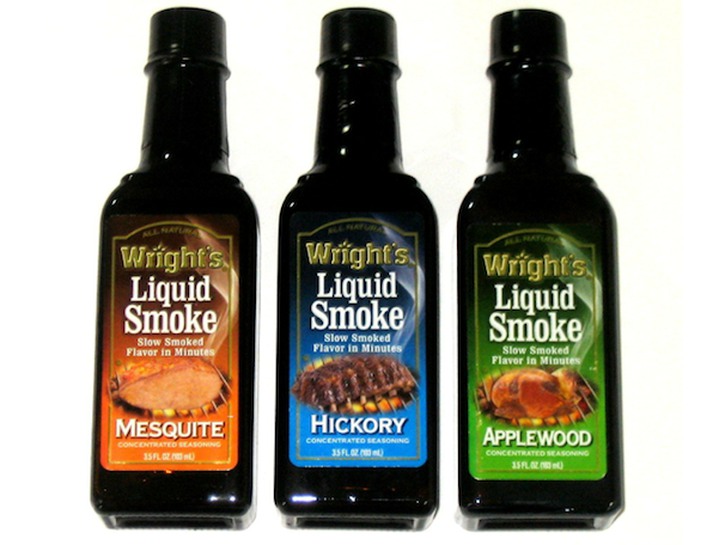Smoking a brisket is perhaps the best — some will say only — way to properly cook this increasingly popular cut of beef. There are times, however, when people don’t have the time or means to spend 12 hours tending to a temperamental smoker. What would a would-be bbq master do in their hour of desperation?
“Grab a bottle of Liquid Smoke,” might not be the first thing that comes to mind, but in times of need, some will argue that it’s one way to get the smokey taste when in a tough spot.
But the question remains — what is liquid smoke and why would anyone use it?
What Is Liquid Smoke?

Liquid smoke isn’t some clever name to describe a product, it’s literally smoke that has been condensed down into a water-soluble liquid that is used to replicate the flavors from the smoker without having to use a smoker.
History
This controversial condiment was first invented by E.H. Wright in 1895 after the Missouri chemist noticed a black liquid trickling down a stovepipe. Wright soon discovered that the liquid was smoke from the stove that upon making contact with the cold air outside the stove condensed into a liquid.
Wright tried out the “Liquid Smoke” as a coating on ham and before he knew it, he had something special on his hands.
Liquid Smoke grew in popularity in the advent of the American suburb in the years following the Second World War. American’s craving for the condiment only grew in the early 1960s when the American Food and Drug Administration declared Liquid Smoke safe for consumption.
How It’s Made
Though the exact process differs from manufacturer to manufacturer, Liquid Smoke is still made in the same way Wright first made it in the 19th century.
You start by burning chunks of wood (or sawdust products from lumber yards). The steam generated by the burning of the wood turns into droplets that are then caught with a condenser and allowed to cool. Before you know it, you have Liquid Smoke.
Why Do People Use It?

Ever since the product’s inception more than 100 years ago, Americans have used Liquid Smoke as a cheap and quick way to flavor foods.
Ways It’s Used
While predominantly used to mimic the smokey flavor of wood smoker or barbecue grill, Liquid Smoke can also be found in barbecue sauces and marinades (both commercial and at-home), hot dogs, smoked meats, and even some cheeses.
In most cases, Liquid Smoke is incorporated into a dish by adding a few drops in order to add a smoky nuance. The quantity used, however, should be comparable to the size of the meat, cheese, or sauce you are preparing.
No matter how Liquid Smoke is used, it should be noted that it only takes a few drops to mimic the smokey flavors of a wood smoker. A little goes a long, long way.
Are There Substitutes?
If you don’t want to use Liquid Smoke or you don’t know where to find it at the store, you can always use a substitute, which there are many of.
It’s safe to say that a lot of people have jars of Spanish smoked paprika in their spice cabinet, which makes this an ideal alternative. The smokiness of the paprika is remarkably similar to Liquid Smoke.
Chipotle powder is also another ideal candidate to replace Liquid Smoke in a recipe. Mostly used to added smokiness to man Mexican and Southwestern dishes, chipotle powder can be used in a number of different dishes.
Smoked meats like smoked fish, chicken, turkey, or ham can also be used as an alternative for Liquid Smoke. If a recipe calls for fresh salmon and liquid smoke, simply use smoked salmon in its place.
Is It Safe To Use?

Research Liquid Smoke long enough and you’ll come across countless inquiries from people asking if the product is safe for human use. Due to the nature of Liquid Smoke containing smoke, it contains polycyclic aromatic hydrocarbons (PAHs), which can be carcinogenic.
A study conducted by the American Chemical Society in 2000 came to the conclusion that Liquid Smoke and similar flavors contain PAHs, but that none of the five flavors tested had high levels.
Is It Natural?
As weird as it may sound, Liquid Smoke is in fact natural and is created through the natural process of burning wood and allowing the smoke to condense into a liquid form upon cooling. Most producers of Liquid Smoke will claim that the contents of the bottles contain water and smoke, which in most cases is hickory smoke due to the distinct smell and flavor.
In addition to saying that Liquid Smoke is safe for human consumption, the FDA also declared Liquid Smoke to be a natural substance, which has allowed manufacturers like bacon producers to claim that their products are made naturally, even when they use Liquid Smoke for flavoring instead of smoking the pork the traditional way.
Are There Health Concerns?
Liquid Smoke contains carcinogens thanks to the product being derived from actual smoke, but that only means that the liquid has the same health risks as smoke.
There are inherent risks with just about everything people put into their bodies, but added a teaspoon of Liquid Smoke to your barbecue sauce or smoked brisket isn’t going to give you cancer overnight.
Hopefully this explains the basic gist of Liquid Smoke, its uses, where it comes from, and the impact it can potentially have on someone’s health.
